0.1 Divisibility and Factorization
Karen Perilloux; Prakash Ghimire; Kristina VanDusen; and Lauren Johnson
Learning Objectives
By the end of this section, you will be able to:
- Find the prime factorization of a composite number
- Find the least common multiple (LCM) of two numbers
Find the Prime Factorization of a Composite Number
Prime Factorization
The prime factorization of a number is the product of prime numbers that equals the number.
You may want to refer to the following list of prime numbers less than 50 as you work through this section: $$ 2, 3, 5, 7, 11, 13, 17, 19, 23, 29, 31, 37, 41, 43, 47 $$
Prime Factorization Using the Factor Tree Method
One way to find the prime factorization of a number is to make a factor tree. We start by writing the number, and then writing it as the product of two factors. We write the factors below the number and connect them to the number with a small line segment—a “branch” of the factor tree.
If a factor is prime, we circle it (like a bud on a tree), and do not factor that “branch” any further. If a factor is not prime, we repeat this process, writing it as the product of two factors and adding new branches to the tree.
We continue until all the branches end with a prime. When the factor tree is complete, the circled primes give us the prime factorization.
For example, let’s find the prime factorization of 36. We can start with any factor pair such as 3 and 12. We write 3 and 12 below 36 with branches connecting them.
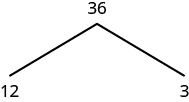
The factor 3 is prime, so we circle it. The factor 12 is composite, so we need to find its factors. Let’s use 3 and 4. We write these factors on the tree under the 12.
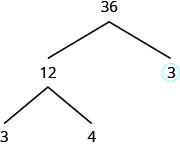
The factor 3 is prime, so we circle it. The factor 4 is composite, and it factors into 2 · 2. We write these factors under the 4. Since 2 is prime, we circle both 2s.
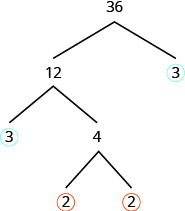
The prime factorization is the product of the circled primes. We generally write the prime factorization in order from least to greatest.
In cases like this, where some of the prime factors are repeated, we can write prime factorization in exponential form.
Note that we could have started our factor tree with any factor pair of 36. We chose 12 and 3, but the same result would have been the same if we had started with 2 and 18, 4 and 9, or 6 and 6.
How To
Find the prime factorization of a composite number using the tree method.
- Find any factor pair of the given number, and use these numbers to create two branches.
- If a factor is prime, that branch is complete. Circle the prime.
- If a factor is not prime, write it as the product of a factor pair and continue the process.
- Write the composite number as the product of all the circled primes.
Mathispower4u. Ex 1: Prime Factorization. YouTube. https://www.youtube.com/watch?v=V_wBWdndCuw
Example
Find the prime factorization of 48 using the factor tree method.
Show Solution
| We can start our tree using any factor pair of 48. Let’s use 2 and 24.
We circle the 2 because it is prime and so that branch is complete. |
 |
| Now we will factor 24. Let’s use 4 and 6. | 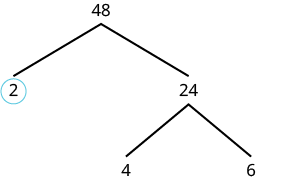 |
|
Neither factor is prime, so we do not circle either. |
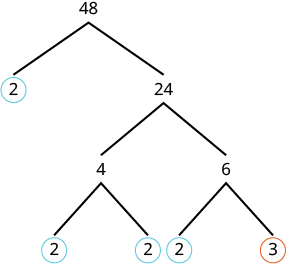 |
| Write the product of the circled numbers. | [latex]2 \cdot 2 \cdot 2 \cdot 2 \cdot 3[/latex] |
| Write in exponential form. | [latex]2^4 \cdot 3[/latex] |
Try It
Find the prime factorization using the factor tree method: [latex]80[/latex]
Show Solution
[latex]2^4 \times 5[/latex]
Try It
Find the prime factorization using the factor tree method: [latex]60[/latex]
Show Solution
[latex]2^2 \times 3 \times 5[/latex]
Example
Find the prime factorization of [latex]84[/latex] using the factor tree method.
Show Solution
Draw a factor tree of 84.
| We start with the factor pair 4 and 21. Neither factor is prime so we factor them further. | 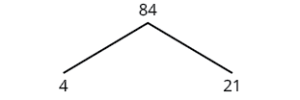 |
| Now the factors are all prime, so we circle them. | 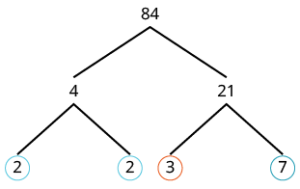 |
| Then we write 84 as the product of all circled primes. |
Try It
Find the prime factorization using the factor tree method: [latex]126[/latex]
Show Solution
[latex]2 \times 3^2 \times 7[/latex]
Try It
Find the prime factorization using the factor tree method: [latex]294[/latex]
Show Solution
[latex]2 \times 3 \times 7^2[/latex]
Prime Factorization Using the Ladder Method
To add a “step” to the ladder, we continue dividing by the same prime until it no longer divides evenly.
Then we divide by the next prime; so we divide 9 by 3.

We continue dividing up the ladder in this way until the quotient is prime. Since the quotient, 3, is prime, we stop here. Do you see why the ladder method is sometimes called stacked division? The prime factorization is the product of all the primes on the sides and top of the ladder.
Notice that the result is the same as we obtained with the factor tree method.
How To
Find the prime factorization of a composite number using the ladder method.
- Divide the number by the smallest prime.
- Continue dividing by that prime until it no longer divides evenly.
- Divide by the next prime until it no longer divides evenly.
- Continue until the quotient is a prime.
- Write the composite number as the product of all the primes on the sides and top of the ladder.
Example
Find the prime factorization of [latex]120[/latex] using the ladder method.
Show Solution
| Divide the number by the smallest prime, which is 2. | |
| Continue dividing by 2 until it no longer divides evenly. |  |
| Divide by the next prime, 3. | 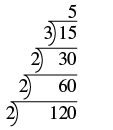 |
| The quotient, 5, is prime, so the ladder is complete. Write the prime factorization of 120. |
Check this yourself by multiplying the factors. The result should be 120 .
Try It
Find the prime factorization using the ladder method: [latex]80[/latex]
Show Solution
[latex]2^4 \times 5[/latex]
Try It
Find the prime factorization using the ladder method: [latex]60[/latex]
Show Solution
[latex]2^2 \times 3 \times 5[/latex]
Example
Find the prime factorization of [latex]48[/latex] using the ladder method.
Show Solution
| Divide the number by the smallest prime, 2. | |
| Continue dividing by 2 until it no longer divides evenly. | 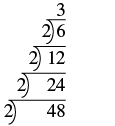 |
| The quotient, 3, is prime, so the ladder is complete. Write the prime factorization of 48. |
Try It
Find the prime factorization using the ladder method. [latex]126[/latex]
Show Solution
[latex]2 \times 3^2 \times 7[/latex]
Try It
Find the prime factorization using the ladder method. [latex]294[/latex]
Show Solution
[latex]2 \times 3 \times 7^2[/latex]
Find the Least Common Multiple (LCM) of Two Numbers
One of the reasons we look at multiples and primes is to use these techniques to find the least common multiple of two numbers. This will be useful when we add and subtract fractions with different denominators.
Listing Multiples Method
A common multiple of two numbers is a number that is a multiple of both numbers. Suppose we want to find common multiples of 10 and 25. We can list the first several multiples of each number. Then we look for multiples that are common to both lists—these are the common multiples.
10: 10, 20, 30, 40, 50, 60, 70, 80, 90, 100, 110, …
25: 25, 50, 75, 100, 125, …
We see that 50 and 100 appear in both lists. They are common multiples of 10 and 25. We would find more common multiples if we continued the list of multiples for each.
The smallest number that is a multiple of two numbers is called the least common multiple(LCM). So the least LCM of 10 and 25 is 50.
How To
Find the least common multiple (LCM) of two numbers by listing multiples.
- List the first several multiples of each number.
- Look for multiples common to both lists. If there are no common multiples in the lists, write out additional multiples for each number.
- Look for the smallest number that is common to both lists.
- This number is the LCM.
Example
Find the LCM of 15 and 20 by listing multiples.
Show Solution
List the first several multiples of 15 and of 20. Identify the first common multiple.
15: 15, 30, 45, [latex]60[/latex], 75, 90, 105, 120
20: 20, 40, [latex]60[/latex], 80, 100, 120, 140. 160
The smallest number to appear on both lists is 60, so 60 is the least common multiple of 15 and 20.
Notice that 120 is on both lists, too. It is a common multiple, but it is not the least common multiple.
Try It
Find the least common multiple (LCM) of the given numbers: 9 and 12
Show Solution
[latex]36[/latex]
Try It
Find the least common multiple (LCM) of the given numbers: 18 and 24
Show Solution
[latex]72[/latex]
Prime Factors Method
Another way to find the least common multiple of two numbers is to use their prime factors. We’ll use this method to find the LCM of 12 and 18.
We start by finding the prime factorization of each number.
Then we write each number as a product of primes, matching primes vertically when possible.
Now we bring down the primes in each column. The LCM is the product of these factors.
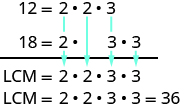
Notice that the prime factors of 12 and the prime factors of 18 are included in the LCM. By matching up the common primes, each common prime factor is used only once. This ensures that 36 is the least common multiple.
How To
Find the LCM using the prime factors method.
- Find the prime factorization of each number.
- Write each number as a product of primes, matching primes vertically when possible.
- Bring down the primes in each column.
- Multiply the factors to get the LCM.
Example
Find the LCM of 15 and 18 using the prime factors method.
Show Solution
| Write each number as a product of primes. | |
| Write each number as a product of primes, matching primes vertically when possible. | |
| Bring down the primes in each column. |  |
| Multiply the factors to get the LCM. | The LCM of 15 and 18 is 90. |
Try It
Find the LCM using the prime factors method: 15 and 20
Show Solution
[latex]60[/latex]
Try It
Find the LCM using the prime factors method: 15 and 35
Show Solution
[latex]105[/latex]
Example
Find the LCM of 50 and 100 using the prime factors method.
Show Solution
| Write the prime factorization of each number. | |
| Write each number as a product of primes, matching primes vertically when possible. | |
| Bring down the primes in each column. |  |
| Multiply the factors to get the LCM. | The LCM of 50 and 100 is 100. |
Try It
Find the LCM of [latex]55[/latex] and [latex]88[/latex] using the prime factors method.
Show Solution
[latex]1320[/latex]
Try It
Find the LCM of [latex]60[/latex] and [latex]72[/latex] using the prime factors method.
Show Solution
[latex]360[/latex]
Key Concepts
Find the prime factorization of a composite number using the tree method.
- Step 1. Find any factor pair of the given number, and use these numbers to create two branches.
- Step 2. If a factor is prime, that branch is complete. Circle the prime.
- Step 3. If a factor is not prime, write it as the product of a factor pair and continue the process.
- Step 4. Write the composite number as the product of all the circled primes.
Find the prime factorization of a composite number using the ladder method.
- Step 1. Divide the number by the smallest prime.
- Step 2. Continue dividing by that prime until it no longer divides evenly.
- Step 3. Divide by the next prime until it no longer divides evenly.
- Step 4. Continue until the quotient is a prime.
- Step 5. Write the composite number as the product of all the primes on the sides and top of the ladder.
Find the LCM by listing multiples.
- Step 1. List the first several multiples of each number.
- Step 2. Look for multiples common to both lists. If there are no common multiples in the lists, write out additional multiples for each number.
- Step 3. Look for the smallest number that is common to both lists.
- Step 4. This number is the LCM.
Find the LCM using the prime factors method.
- Step 1. Find the prime factorization of each number.
- Step 2. Write each number as a product of primes, matching primes vertically when possible.
- Step 3. Bring down the primes in each column.
- Step 4. Multiply the factors to get the LCM.
Section Exercises
Find the Prime Factorization of a Composite Number
In the following exercises, find the prime factorization of each number using the factor tree method.
1. 86
Show Solution
2 ⋅ 43
2. 78
3. 132
Show Solution
2 ⋅ 2 ⋅ 3 ⋅ 11
4. 455
5. 693
Show Solution
3 ⋅ 3 ⋅ 7 ⋅ 11
6. 420
7. 115
Show Solution
5 ⋅ 23
8. 225
9. 2475
Show Solution
3 ⋅ 3 ⋅ 5 ⋅ 5 ⋅ 11
10. 1560
In the following exercises, find the prime factorization of each number using the ladder method.
11. 56
Show Solution
2 ⋅ 2 ⋅ 2 ⋅ 7
12. 72
13. 168
Show Solution
2 ⋅ 2 ⋅ 2 ⋅ 3 ⋅ 7
14. 252
15. 391
Show Solution
17 ⋅ 23
16. 400
17. 432
Show Solution
2 ⋅ 2 ⋅ 2 ⋅ 2 ⋅ 3 ⋅ 3 ⋅ 3
18. 627
19. 2160
Show Solution
2 ⋅ 2 ⋅ 2 ⋅ 2 ⋅ 3 ⋅ 3 ⋅ 3 ⋅ 5
20. 2520
In the following exercises, find the prime factorization of each number using any method.
21. 150
Show Solution
2 ⋅ 3 ⋅ 5 ⋅ 5
22. 180
23. 525
Show Solution
3 ⋅ 5 ⋅ 5 ⋅ 7
24.. 444
25. 36
Show Solution
3 ⋅ 5 ⋅ 5 ⋅ 7
26. 50
27. 350
Show Solution
2 ⋅ 5 ⋅ 5 ⋅ 7
28. 144
Find the Least Common Multiple (LCM) of Two Numbers
In the following exercises, find the least common multiple (LCM) by listing multiples.
29. 8 and 12
Show Solution
24
30. 4 and 3
31. 6 and 15
Show Solution
30
32. 12 and 16
33. 30 and 40
Show Solution
120
34. 20 and 30
35. 60 and 70
Show Solution
300
36. 44 and 55
In the following exercises, find the least common multiple (LCM) by using the prime factors method.
37. 8 and 12
Show Solution
24
38. 12 and 16
39. 24 and 30
Show Solution
120
40. 28 and 40
41. 70 and 84
Show Solution
420
42. 84 and 90
In the following exercises, find the least common multiple (LCM) using any method.
43. 6 and 21
Show Solution
42
44. 9 and 15
45. 24 and 30
Show Solution
120
46. 32 and 40
Everyday Math
47. Grocery shopping Hot dogs are sold in packages of ten, but hot dog buns come in packs of eight. What is the smallest number of hot dogs and buns that can be purchased if you want to have the same number of hot dogs and buns? (Hint: it is the LCM!)
Show Solution
40
48. Grocery shopping Paper plates are sold in packages of 12 and party cups come in packs of 8. What is the smallest number of plates and cups you can purchase if you want to have the same number of each? (Hint: it is the LCM!)
Writing Exercises
49. Do you prefer to find the prime factorization of a composite number by using the factor tree method or the ladder method? Why?
50. Do you prefer to find the LCM by listing multiples or by using the prime factors method? Why?
Glossary
composite number
A composite number is a counting number that is not prime.
least common multiple
The smallest number that is a multiple of two numbers is called the least common multiple (LCM).
multiple of a number
A number is a multiple of n if it is the product of a counting number and n.
prime number
A prime number is a counting number greater than 1 whose only factors are 1 and itself.
prime factorization
The prime factorization of a number is the product of prime numbers that equals the number.
Media Attributions
- 0.1 Fugure 1 © Prealgebra 2e | OpenStax is licensed under a CC BY (Attribution) license
- 0.1 Figure 2 © Prealgebra 2e | OpenStax is licensed under a CC BY (Attribution) license
- 0.1 Figure 3 © Prealgebra 2e | OpenStax is licensed under a CC BY (Attribution) license

